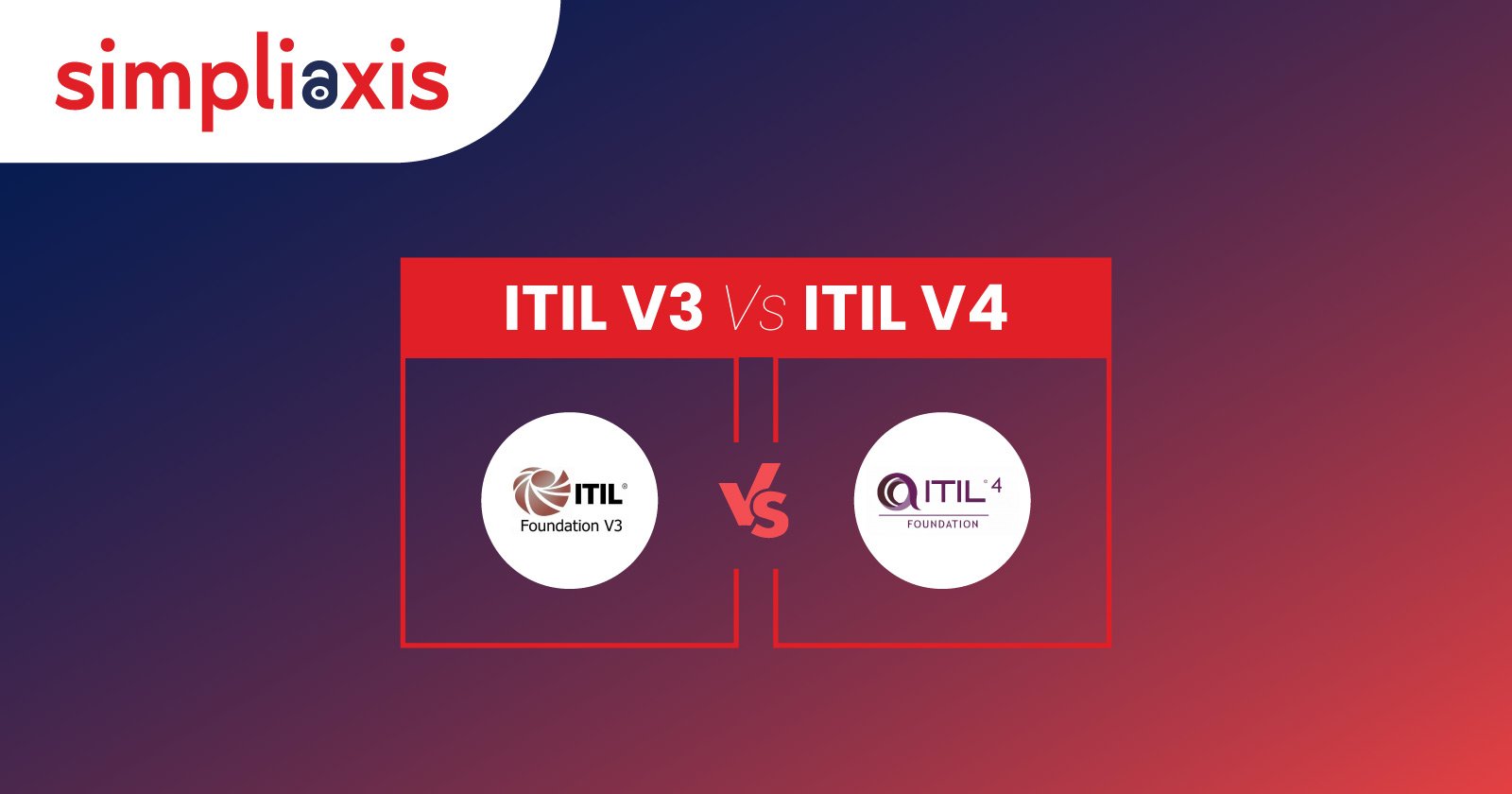Introduction :-
The ITIL framework, or Information Technology Infrastructure Library, is a major framework in IT service management. Because IT is a constantly changing subject, ITIL developers must update it continuously to keep up with contemporary technology and best practices for its management. In light of this, a new version of ITIL, ITIL V4, has been released. One of the fundamental changes has been an orientation toward the Lean-Agile approach. This article will explain the significant modifications implemented in the current edition of ITIL through this post on ITIL V3 versus ITIL V4.
ITIL Version 3
ITIL V3 is the third edition of the Information Technology Infrastructure Library model, corresponding to a compilation of widely accredited best practices for managing information technology. This approach highlights the notion of IT as a service that aids in achieving business objectives. ITIL V3 was published in 2007 and is considered to be one of the most widely adopted ITSM frameworks. The crucial aspect of ITIL is that it is constantly growing to meet the current business environment better. To comply with the recent technologies or practices such as DevOps, Lean, and, most notably, Agile, the designers of ITIL have created a new framework known as ITIL 4 that meets the needs of the customer or IT company. The following section will deal with a brief outline of ITIL 4.
The ITIL V4 framework features four dimensions instead of the four Ps that were used in the ITIL V3 framework.
- People
- Process
- Products
- Partners
ITIL Version 4
ITIL V4 is an updated version of the ITIL V3 framework that was launched in 2019. It incorporates enhanced competitive features that allow greater integration of IT service management with business objectives. ITIL V4 aims to aid in developing a successful IT Service Management strategy by offering an effective end-to-end methodology for designing, delivering, and continuously improving technologically enabled goods and services.
ITIL V4 also gives businesses the information to solve emerging service management problems. It aids in unlocking the benefits of contemporary technology in an age of Agile, DevOps, Cloud, and constant change. The ITIL Service Value System (SVS) and the four dimensions model are the significant elements of ITIL V4. These dimensions are
- Organizations and People
- Information and Technology
- Partners and Suppliers
- Value Streams and Processes.
These components represent a substantial advancement in ITIL over earlier versions. They embody a change from a narrow focus on service delivery to a broader view of the value produced by the goods and services provided to customers and stakeholders.
Service management was introduced in ITIL V3 as a "systems approach" with interrelated assets and components. However, it did not precisely specify a four-dimensional model or the role of these features in service management.
ITIL 4 is intended to facilitate a smooth transition from an organization's present ITIL and working style to a speedier, more flexible, more Lean-Agile approach.
With these things in mind, we will proceed to the salient differences between ITIL V3 and ITIL V4.
Key Differences Between ITIL V3 and ITIL V4
A process in ITIL v3 is a set of actions. A process is now called a practice in ITIL 4, and it indicates actions that can be performed with the right tools. The phases and sequential activities provided by ITIL v3 procedures include recommendations for delegating tasks and tracking advancement. In contrast, ITIL 4 practices are the capabilities that an organisation can achieve.
The 34 Management Practices in the more recent version, which are categorised into three groups, incorporate many of the 26 procedures from the Service Lifecycle of ITIL v3.
ITIL v4 is more focused on subjects like value, costs, risks, and outcomes. The core principles of this fourth edition depend on a powerful combination of ideas supplied by ITIL Practitioner. The following are these principles:
- Focusing on value
- Starting from where you are
- Progressing with feedback on iterations
- Collaborating and promoting visibility
- Thinking and working holistically
- Keeping it real and simple
- Optimising and automating.
ITIL 4 generally updates and modernises any previous knowledge of ITSM. However, a number of relevant concepts and beliefs from its pioneers are still present. A list of all the variations between ITIL v3 and v4, depending on several framework areas, is provided below:
Key Difference | ITIL V3 | ITIL V4 |
| Terminology | Describes processes as sequences of activity. | Refers to practices, emphasizing organizational abilities. |
| Number of Components | 26 processes organized into 5 lifecycle stages. | 34 practices organized into 3 categories. |
| Service Life cycle Vs Value system | Service Life cycle : Five Phases Based on a linear service lifecycle model. | Service Value System (SVS) |
| Continual improvement | Continual Service Improvement (CSI) model. | Renamed to Continual Improvement (CI) with a structured approach. |
| Guiding Principles | 9 guiding principles. | Reduced to 7 guiding principles. |
| Four P vs Four Dimensions | Focuses on Four P's: People, Partners, Products, Processes. | Replaced by Four Dimensions: Organizations and People, Information and Technology, Partners and Suppliers, Value Streams and Processes. |
| Integration with other frame works | Primarily a standalone approach. | Focuses on integrating multiple frameworks, including Agile and DevOps. |
Learn More About:
Re-orientation towards Agile
ITIL V4 fosters the integration of Agile and DevOps into ITSM practices and emphasizes moving away from a siloed approach, better collaboration, and easier communication throughout the entire organization. ITIL 4 is intended to be more adaptable and easily customizable. In sum, ITIL 4 promotes a more comprehensive approach to information technology.
The Agile approach dictates that an iterative approach to project management and software development must be followed.
This approach enables teams to provide value to their clients quickly and with fewer impediments. An Agile team provides work in tiny, digestible chunks with shorter time horizons (usually eight to twelve weeks). Teams have a natural mechanism for adjusting to change fast since they regularly assess requirements, strategies, and outcomes. Moreover, they are given more autonomy while working, enabling them to make timely changes as per changing customer demands and business needs.
Unlike the conventional "waterfall" model, which requires one department to contribute to the project before "throwing it over the wall" to the next, Agile requires collaboration from cross-functional teams. Thus, to follow an Agile approach, a team must have open communication, cooperation, and trust. Although the project leader or product owner usually prioritizes the work to be delivered, the team decides how the work will be completed, self-organizing around smaller tasks and manageable assignments.
A focus on costs, outputs, risks, and value is more prominent in ITIL 4. The foundational principles of the new edition were not a part of the ITIL V3 and are based on a good corpus of ideas prescribed by the ITIL Practitioner. They are:
- Focus on value
- Start where you are
- Progress iteratively with feedback
- Collaborate and promote visibility
- Think and work holistically
- Keep it simple and practical
- Optimize and automate
As it is suggested before, ITIL V4 places a stronger emphasis on value creation.
ITIL V4 divides its practices into three constituent headings: General Management, Service Management, and Technology Management instead of ITIL V3's Service Strategy, Service Design, Service Transition, Service Operation, and Continual Service Improvement.
The ITIL 4 model for continuous improvement outlines a structured way to identify and execute improvements at all levels of a business. ITIL 4's continuous improvement model has seven steps, similar to ITIL V3's seven-step improvement process in several areas. Further, there is limited guidance on infrastructure and platform management in ITIL V3. At the same time, ITIL V4 practice covers the governance of the usage of technologies in an organization with an updated set of practices and procedures for cloud services and cloud computing.
Also, Check:ITIL vs ITSM: Understanding the Key Differences
Conclusion
In conclusion, ITIL 4 is a refinement of ITIL V3. It highlights the changes in a corporate culture where teamwork and communication are given more importance, and the integration of IT into the overall business structure is crucial. More saliently, it marks a shift towards the Lean-Agile and DevOps approach, enabling an organization to adapt to changing circumstances. As an added advantage, it prescribes that organizations foster collaboration and trust among their teams to arrive at mutually beneficial results. Further, ITIL V4 makes some significant and practical changes in terminology, like its shift from "process" to "practice." This change has broader implications on how one thinks about the organization and the route to achieving its objectives. Finally, a renewed focus on 'value' underscores the need to understand business organizations as value-creating entities and optimize their value delivery mechanisms. Simpliaxis is one of the leading professional certification training providers in the world, offering courses related to IT service management (ITSM). We offer ITIL 4 Foundation Certification Training to both individuals and corporate groups through instructor-led classroom and online virtual sessions.






















